Stepwells, in simple term, “Wells which have Stairs” But the science behind this isn’t that simple.
In India, stepwells are standing since the age of Harappa and Mohenjo-Daro, which is as old as 2500 BCE, roughly 4500 years old. During this period, square bath wells with steps created, with surrounding rooms and one could rest for a while.
So, coming back to 3500 years after Mohenjo-Daro, India had stepwells which were much deeper, have room type structure on two sides (or even 1), and travelers or commuters use to rest in them as the temperature in these Stepwells are 5-degree lower than the actual temperature outside.
My journey of Ancient Indian Stepwells
From July 2016, I’ve visited five states in India, {New Delhi, Haryana, Rajasthan, Gujarat, and Karnataka} to capture pictures & local stories connected with two dozen stepwells.
My goal is to create a “Guide on Ancient Indian Stepwells,” to bring more light on a particular “Made in India” architecture and science which is on the verge of being instinct. In my travels, I did see one & only 21st-century Stepwell in Jodhpur which has given me hope that Stepwells are still very much useful in the modern digital age.
Below is a list of popular and some not so famous stepwells, which I’ve explored since July’16 and my journey has just begun. I’ll visit & add more stepwells in this list on the Grandest Guide on Ancient Indian Stepwells.
Stepwell Number 1 – Agrasen Ki Baoli
Location – Kasturba Gandhi Marg, Hailey Lane, New Delhi, INDIA
Age – 1132 AD
Built by – Aggarwal Communities of 12 century Delhi

Agrasen ki Baoli
Agrasen Ki Baoli is a very popular Stepwells as it has been featured in many travel books, guides, movies and the location of this Stepwells is at KG Road, near Connaught Place, which is a prime locality in New Delhi. This stepwell is suggested to be as old as 12th century though there aren’t many written facts about this date.
The design of Agrasen Ki Baoli has arch gates, which suggests that’s it’s an architecture of 12-14th century Northern India, which was the Lodhi era (Delhi Sultanate).
Many have also tagged this Baoli with Mahabharata era king, Maharaja Agrasen, which makes this stepwell as the oldest one in India.
Apart from this ongoing debate on this stepwell age, Agrasen Ki Baoli is a four storey stepwell which is 60-meter-deep and 15-meter-wide. This stepwell was and is still used by travelers to rest, and today it has become a popular hangout place for couples in New Delhi.
The architecture of this stepwell is simple but massive, and the sight of skyscrapers behind it makes Agrasen Ki Baoli as iconic stepwell of Delhi and India.
Check out the whole history and more pictures of Agrasen Ki Baoli.
Stepwell number 2 – Chand Baori
Location – Abhaneri Village, near Jaipur, Rajasthan, INDIA
Age – Between 800-900 AD
Built by – Maharaja Chand

Chand Baori, Abhaneri Rajasthan
Chand Baori is by far, the most famous stepwell site in India as it’s architecture has not only helped the locals to conserve water for many centuries, but it has also attracted many travellers & Hollywood directors, to feature this unique stepwell in their films.
Maharaja Chand built Chand Baori as a water reservoir, and he dedicated this baori (stepwell) to a Goddess Harshat Mata, whose temples is built just next to Chand Baori. Later in the 18th century, Mughals Empire also did some restoration work here and added more rooms here.
The thing which attracts travelers and filmmakers towards Chand Baori is it’s 3500 steps which are all identical, room architecture built on one side of the stepwell and the science to store rainwater water for years.
Though it has been suggested that Chand Baori was constructed as a temple stepwell but as per me, the only reason King Chand invested so heavily in this project, was to make sure that there is no water shortage in his kingdom, as Abhaneri is a drought prone area.
Check out the whole history and more pictures of Chand Baori.
Stepwell number 3 – Hadi Rani Ka Kund
Location – Todarraisingh, District Tonk, Rajasthan, INDIA
Age – 1901 AD (not confirmed)
Built by – Local people of Todarraisingh

Hadi Rani Ka Kund, Todaraisingh Rajasthan
Most stepwells in India are found in the state of Rajasthan and as people make statues all over the world to remember someone, similarly Kund (Stepwell) were made in Rajasthan to remember someone for a noble cause.
In the city of Todaraisingh (Tonk District), a stepwell was built and named after Hadi Rani, who was the wife of Ratan Chudawat, a commander in Mewar Army of late 17th century and chief of Todaraisingh.
It’s is said by the locals, that Ratan Chudawat was hesitating to join the war against the Mughals as he didn’t want to leave his newly married wife, Hadi Rani. But Hadi Rani, who was the daughter of Hada Rajput family knew that the absence of Ratan Chudawat in war would bring shame on her husband and thus she gave a souvenir to boost her husband morale. It was her chopped head on a plate.
This sacrifice made Ratan Chudawat full of rage and he fought bravely & even defeated the Mughals on that day. But he later killed himself as he couldn’t bear the sacrifice of his wife.
So, to remember the sacrifice of Hadi Rani, a Kund was built in Todarraisingh, named as Hadi Rani ka Kund, which wasn’t just used to store water but also as a symbol of sacrifice which is still remembered today.
View more details and pictures of this king at my article on Hadi Rani Ka Kund.
Stepwell number 4 – Raniji Ki Baori
Location – Bundi, Rajasthan, INDIA
Age – 1699 AD
Built by – Queen Nathavati

Raniji Ki Baori, Bundi Rajasthan
Around 220 km south from Jaipur, lies a beautiful city of Bundi, which has a colorful history of more than 800 years. Bundi is also described as the “City of Stepwells” as it has more than 50 stepwells and the one which is known as Queen of all Stepwells in Bundi is Raniji Ki Boari or Queen Stepwell.
Raniji Ki Boari was built in 1699 AD, by Nathavati (queen of Bundi). Raniji Ki Boari is a royal Stepwell and has religious importance. Even today many festivals in Bundi start from this site, and the architecture here leaves no doubt that it is one of the most royal stepwells of Rajasthan.
There are three main gates in the Queen’s Stepwell and all these three large arched gates with statues of elephants on all its pillars. The most decorated gate is the final one that has beautiful stone carving done on all four sides, and the reflection of that gate on the stepwell water makes it more stunning.
You can check more details and picture this stepwell at my article on Raniji Ki Baori.
Stepwell number 5 – Rani Ki Vav
Location – Patan, Gujarat, INDIA
Age – 1022-64 AD or 1364 AD
Built by – Queen Udayamati

Rani Ki Vav, Patan Gujarat
Though the name of Rani Ki Vav is very similar to Raniji Ki Baori; but let me assure you that these two stepwells have nothing in common and neither the maker of these stepwells were close relatives.
Built in 11th century by Queen Udaymati, Rani Ki Vav was constructed to remember the life of King Bhima I of Gujarat. There is still many questions about the correct date of this vav (stepwell), but a calculated guess is that this stepwell was built in the 11th century, and today it is the only UNESCO World Heritage Stepwell in India.
Dimensions of Rani Ki Vav is 27 meters deep, 20 meters wide and 64 meters long, making it one of the biggest stepwells in the world. But the main attraction of this Vav isn’t its dimension but it’s 800 sculptures, build inside this stepwell.
Rani Ki Vav is a five storey or phase stepwell and the last two floors have more than 600 statues of characters from Hindu mythology like Vedic gods Indra, Agni (god of fire), Apsaras (Angels) and figures of Shiva, Brahma, Vishnu and ten incarnations of Vishnu. Also described as Dashavatar.
It is also fascinating to know that Rani Ki Vav disappeared for many centuries and it was in the year 1980 when this stepwell was discovered again.
Along with UNESCO World Heritage award, Rani Ki Vav is also was the Indian Sanitation Conference (INDOSAN) 2016 making it the cleanest tourist attraction in India.
For more details and pictures, have a look at my post of Rani Ki Vav,
Stepwell number 6 – Adalaj Vav
Location – Adalaj, Near Gandhinagar, Gujarat, INDIA
Age – 1599 AD
Built by – Sultan Mahmud Begada of Gujarat, India

Adalaj Vav, Gandhinagar Gujarat
The Vav of Adalaj is a beautiful Stepwell site and also have a tragic tale. Adalaj Vav was built by the Sultan of Gujarat Mahmud Begada, but originally the work on this Vav (stepwell in Gujarati language) was started by Rana Veer Singh, who was chief of Adalaj.
It is said that Rana Veer Singh wanted to construct a stepwell for his people who had travel a lot just to collect water for daily use. At the same time, Mahmud Begada was expanding his territory in Gujarat, and he attached Rana Veer Singh and killed him in battle.
After winning the city of Adalaj, Mahmud Begada met with Rana Veer Singh wife Rudabai and felt in love with her. He asked the Rudabai to marry him which the widowed queen didn’t refuse, but she put up a condition that first, the Sultan need to finish the Vav work which was started by her late Husband Veer Singh.
Mahmud Begada agreed to this condition and finished up the work of Adalaj Vav by 1599 AD. He not only concluded the work of the Vav but built a stepwell which is a mixture of Hindu, Jain and Islamic architecture. There are three entry gates of the Vav, and the 1st floor has two beautiful windows with stunning stonework done on them.
There are a total of 5 floors in Adalaj Vav. From the 3rd to the last floor, beautiful craftsmanship is presented on the Vav pillars, beam and statues of plants & flowers are carved out on all floors. The final level of the Vav has an octagonal shaped well & thus many have also termed Adalaj Vav as an octagonal shaped Stepwell.
But all this work didn’t allow Mahmud Begada to marry Rudabai, as the widowed queen jumped the Adalaj Vav and died. And this sacrifice also earned a second name to Adalaj Vav, which is Rudabai Vav.
You can check my article on Adalaj Vav for more images and details on the beautiful stepwell site in Gandhinagar, Gujarat.
Stepwell number 7 – Hampi Pushkarini
Location – Hampi, Karnataka, INDIA
Age – 15-16 century
Built by – Not sure (Suggested by Locals Raja Krishnadevaraya)
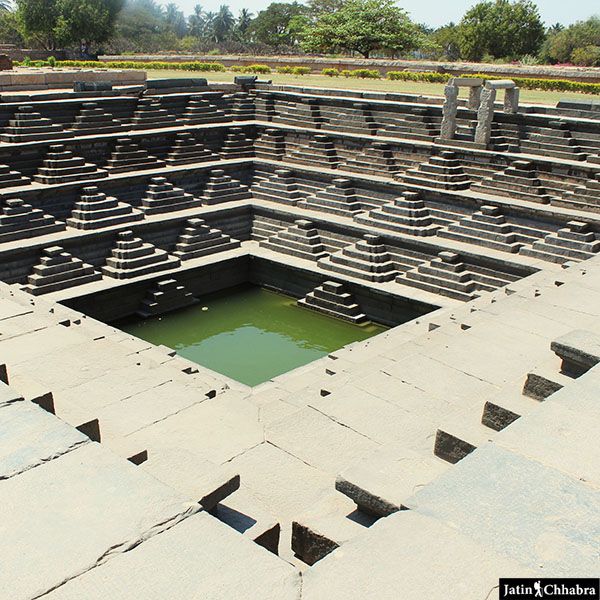
Hampi Pushkarani
Hampi was the capital of Vijayanagara Empire, a 16th-century kingdom in southern India which even the Romans has described as the second most powerful & richest country in the world. As they considered themselves as the first :)
Though Vijayanagara Empire was blessed with good monsoons, still the kingdom had to face continuous droughts for years. So, to solve this problem, rulers of Hampi invested time and money in Pushkanani (Stepwell).
A Pushkanari is a stepwell built to conserve rain water, not by just collecting water which comes in them, but with a series of small ponds and wells which are interconnected and can store rainwater for a decade.
One of the best examples of these Pushkarani is the Hampi Pushkanari which was built along with a Goddess temple. Though this stepwell was just used for temple ceremonies, but it was a part many stepwells formed in the city.
Just next to this stepwell, there is a huge (100 times bigger) Pushkanari which I believe is the most biggest stepwell site once can see in Southern India.
The above seven stepwells are my favorite and below you will find the list of Stepwells I’ve visited, as per their states. So, let’s start with:
Stepwells of New Delhi.
It is true that Agrasen ki Baoli is a very popular stepwell site in New Delhi, but there many more stepwells sites build in India’s capital and are worth exploring. So, first in our list of Stepwell or Baoli’s in New Delhi, I present:
Stepwell number 8 – Rajon Ki Baoli (Rajon Stepwell)
Location – Mehrauli, New Delhi, INDIA
Age – 1516 AD
Built by – Daulat Khan, Governer in Lodhi Empire

Rajon Ki Baoli
Rajon Ki Baoli is in Mehrauli Archaeological Park, near Qutub Minar, know for the ruins of 11th to 15th-century historic sites belonging to Tomar Rajputs and Khalji, Tughlaq & Lodhi dynasty. The last three also described as the Delhi Sultanate.
The term Rajon here is used to describe “Rajmistry” (construction workers), and thus it should not be confused with Hindi term “Raja” which means King.
Rajon Ki Baoli was built by Daulat Khan who was the governor of Lahore under Lodhi Dynasty. This stepwell was a resting palace for travelers visiting Delhi and for the pilgrims, coming for prayers in a mosque just next to the Baoli.
Rajon Ki Baoli is a three storey stepwell with room type structures on its first floor and a few more on the second & third floor. The ASI (Archaeological Survey of India) has carried out some restoration work, but sadly, this baoli isn’t good condition as Agrasen Ki Baoli.
Stepwell number 9 – Gandhak Ki Baoli
Location – Mehrauli, New Delhi, INDIA
Age – 1211-1236 AD
Built by – Emperor Iltutmish
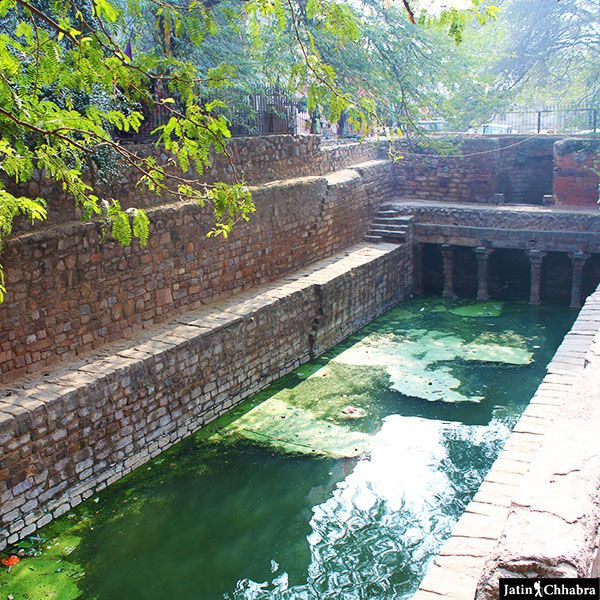
Gandhak Ki Baoli
Gandhak Ki Baoli is second of three stepwells in Mehrauli Archaeological Park. There is not a confirmed date of this stepwell, but it’s suggested to be built during the regime of Iltutmish, which is from 1211 to 1236 AD.
The term Ghandhak is an Urdu word for Sulphur, and many have suggested that the water in this stepwell has a high amount of Sulphur. And thus a theory has been tagged with Ghandhak Ki Baoli that the water in the stepwell can cure many diseases.
FYI – It’s just a theory, so I don’t advise to drink water from this Baoli.
Ghandhak Ki Baoli isn’t as attractive as other popular stepwells in Delhi, but still, it’s structure has not faded in the last 800 years. The locals do use the rain water stored here for the whole year; making is one of very few active stepwell site in New Delhi.
Apart from these two stepwells, there are like two dozens stepwells in New Delhi. I’ve visited the ones above, and I plan to visit a few more stepwell in Delhi which are:
- R.K Puram Baoli
- Red Fort Baoli
- Purana Qila Baoli
- Firoz Shah Kotla Baoli
Stepwells of Haryana
The majority of stepwells in New Delhi came into existence from 11th to 16th century, and the same Sultans & Empires (of Delhi) also built many stepwells in the current state of Haryana.
Though over the time, many stepwells in Haryana have disappeared, thanks to unplanned urbanization, but still I was able to visit two stepwells and have one more in the bucket list.
So, here are a few stepwells from Haryana.
Stepwell number 10 – Baoli Ghaus Ali Shah
Location – Farrukhnagar, near Gurgaon (Gurugram), Haryana, INDIA
Age – 18th Century
Built by – Ghaus Ali Shah, Chief in Mughal Army

Baoli Ghaus Ali Shah
Just 40 km from New Delhi, in a peaceful village of Farrukhnagar, there is a stepwell by the name of “Baoli Ghaus Ali Shah,” built by an army chief in Mughal Emperor, Farrukh Siyar.
When I visited Baoli Ghaus Ali Shah, restoration work had just finished there, and it was not done by any local government or ASI, but by the local villagers who treat the stepwell as a historical monument of their village.
The stepwell is more octagonal shaped well and is just one storey deep. As per the tourism archive of Haryana, Baoli Ghaus Ali Shah architecture is inspired by Turkish Hammam, which suggests that the stepwell was not for travelers or commuters passing by but more of a private Hammam (bath) for the high class..
Stepwell number 11 – Narnaul Mukendpura Baoli
Location – Mukendpura Village, Narnaul, Haryana
Age – ??? AD
Built by – ???

Narnaul Mukendpura Baoli
Narnaul is a small city in Haryana and has many historical events tagged with itself. Like the Battle of Narnaul where Pran Sukh Yadav and Rao Tula Ram fought against the Britishers in 1857, the first war of Independence.
I came to know about this fact when I decided to visit the Narnaul Mukendpura Baoli. But let me clear some wrong information mentioned about this stepwell on the net.
First, the stepwell isn’t in Narnaul, it’s in a nearby village, Mukendpura and that’s why I have mentioned Narnaul Mukendpura Baoli in the title above.
Secondly, no government agency has done anything to protect the Baoli, but thanks to the local villagers of Mukendpura, who don’t have a solid road in their village but still, they clean up the stepwell once every year as a sign of respect to this heritage site of their village.
Now Narnaul Mukendpura Baoli, isn’t a fancy stepwell as the ones mentioned above but the locals here are very helpful and that’s why I’ve included Narnaul Mukendpura Baoli in my guide of Ancient Indian Stepwells.
You can more details and pictures of on this stepwell at my article on Narnaul Mukendpura Baoli.
Apart from these two stepwells or baoli’s in Harayana, I’ve plans to visit the Shahjahan ki Baoli which is at Meham, near Rohtak, Will soon add pictures and details about Shahjahan ki Baoli.
Stepwells of Rajasthan.
If the city of Bundi, is referred as the “City of Stepwells” then Rajasthan is “The State of Stepwells.” as the highest number of Indian Stepwells are in Rajasthan.
I’ve included Chand Baori, Hadi Rani Ka Kund and Raniji Ki Baori in top 7 on this list and I’ve got a few more Stepwells which I’ve explored in Rajasthan. They are:
Stepwell number 12 – Neemrana Bawdi or Baoli
Location – Neemrana, Rajasthan, INDIA
Age – 1760 AD
Built by – Neemrana Royal Family

Neemrana Bawdi is one of the deepest stepwells site in Rajasthan and till today, I have just one more stepwell which is as deep as Neemrana, that’s Rani Ki Vav, Gujarat.
Again, no government agency maintains this stepwell, and it’s the local people who clean it up one in a decade. But never the less, the stepwell is still in excellent condition as there aren’t many commercial activities going around it.
As per some locals, Neemrana Bawdi was built the Royal Family of Neemrana, for travelers who use to rest here. Now as there isn’t any government archive on this stepwell, and the local conditions suggest that there must have been a shortage of water in this royal city. So, the family who uses to rule here must have to develop a stepwell to store rainwater. And my thought gets more strength as there is a huge cylindrical well in Neemrana Stepwell which suggested that water conservation was the main reason behind this stepwell.
One can also visit the Neemrana Fort Palace, which is just 2 km from the stepwell site and you can check more details and images of this stepwell at my post of Neemrana Bawdi.
Stepwell number 13 – Panna Meena Ka Kund
Location – Amer Jaipur, Rajasthan, INDIA
Age – 16th century
Built by – No confirmed data

Panna Meena Ka Kund
Panna Meena Ka Kund is small stepwell site, made up of yellow sandstone and is quite similar to Chand Baori, as both of them are square shaped stepwells and room type structure on just one side.]
Though I didn’t see any sign board of ASI or any government agency maintaining this stepwell, still, this 450-year stepwell is still in good shape and has a sufficient amount of water stored and local use thus stepwell as a diving pool.
There are many theories about Panna Meena Ku Kund, and the most common one is that this stepwell acted as a popular social gathering place for women and also for religious ceremonies as I did see ancient temple just next to the Kund (a type of stepwell)
You can have a look at more pictures and details about this stepwell at my article on Panna Meena Ka Kund.
Stepwell number 14 – Dhabhai Ji ka Kund
Location – Bundi, Rajasthan, INDIA
Age – 1658 AD
Built by – Rao Raja Bhao Singh
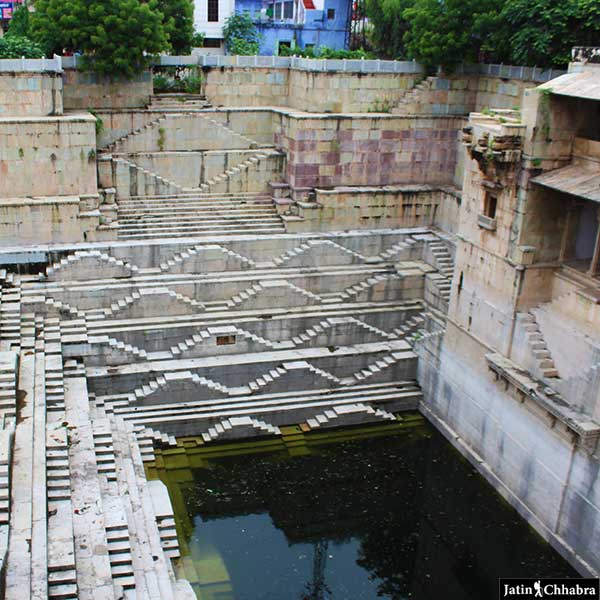
Dhabhai Ji ka Kund
Dhabhai is a local term for “Dhai” which means “Foster Mother” and this stepwell was built by a King of Bundi, Rhao Bhao in 1658 to remember his foster mother, Sabeera.
The shape and design of Dhabhai Ji ka Kund is very similar to Chand Baori as it’s a square shaped stepwell and rooms type structure on one side.
Dhabhai Ji ka Kund was used for religious ceremonies from 17th to 19th century but nowadays this kund is empty, and if some rainwater gets stored here, it is again used as a diving pool by locals or even some travelers.
If you are more interested in visiting this stepwell, and others like Raniji Ki Baori, then check out my tourism guide on Bundi which I wrote after my three days tour of the city.
Stepwell number 15 – Toor Ji Ka Jhalra
Location – Jodhpur, Rajasthan, INDIA
Age – 6th Century AD
Built by – No confirmed data
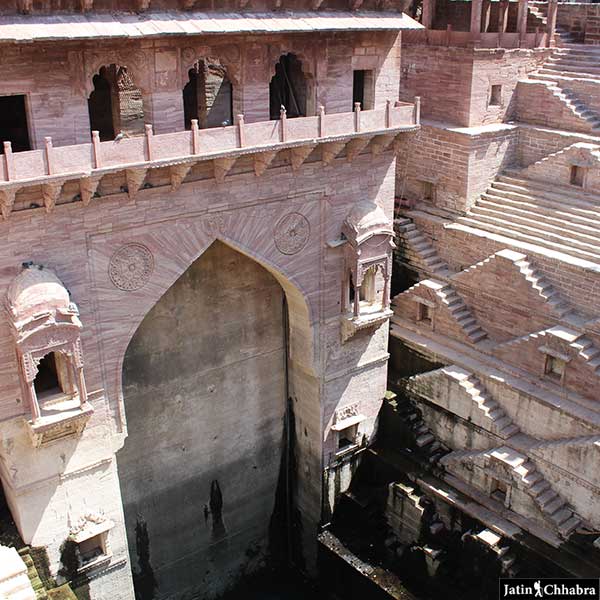
Toor Ji Ka Jhalra
Toor Ji Ka Jhalra or Toor Ji ki Baori or Toor Ji Ka Zhalra is one of three stepwells I explored in Jodhpur. There isn’t much data on who built this stepwell or what’s the correct origin date, but one thing is sure that Toor Ji Ka Jhalra has a special place in the heart of locals.
Toor Ji Ka Jhalra was one of the primary sources of water in Jodhpur, till 1996. After this, the Indira Gandhi canal project was introduced in Jodhpur, and the city was now getting water directly through dams and water treatment plants.
So, all stepwells in Jodhpur become useless, but Toor Ji Ka Jhalra survived as this it’s connected with many local customs related to Hindu marriage, where the bride comes here just before the big day.
And thus, Toor Ji Ka Jhalra is one of those stepwells which can provide clean water, thanks to the people of Jodhpur, who maintain this 6th-century wonder. You can check my article for more images with more pictures & details of Toor ji ka Jhalra.
Stepwell number 16 – Mahila Bagh ka Jhalra
Location – Jodhpur, Rajasthan, INDIA
Age – No confirmed data
Built by – No confirmed data
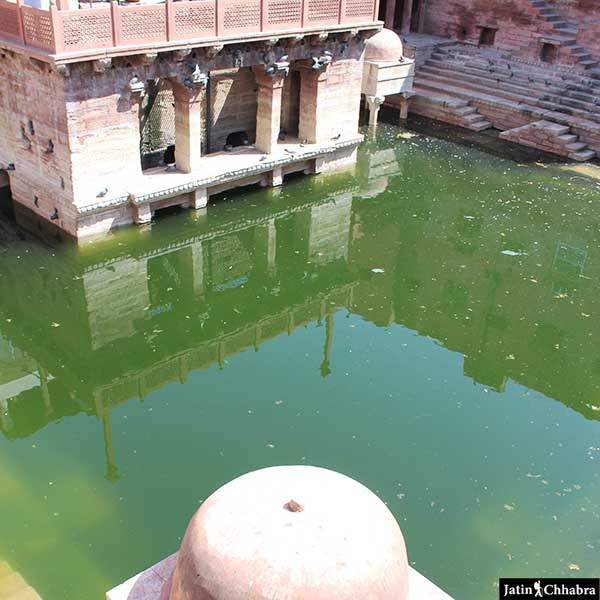
Mahila Bagh ka Jhalra
Mahila Bagh Ka Jhalra is the second stepwell I visited in Jodhpur. This stepwell caught the attention of Indian and Irish Media when a traveller name, Caron Pierre voluntary took the responsibility to clean Mahila Bagh Ka Jhalra with his own hands. Caron hard work also inspired many locals and travellers visiting Jodhpur to clean this stepwell.
Though today, this Jhalra (Stepwell) is not as clean as Caron left but still Mahila Bagh Ka Jhalra is worth a visit in Jodhpur. You can check my article with more pictures and details on Mahila Bagh Ka Jhalra.
Stepwell number 17 – Birkha Bawri
Location – Jodhpur, Rajasthan, INDIA
Age – 2005-2008 AD
Built by – A. Mridul, Architect
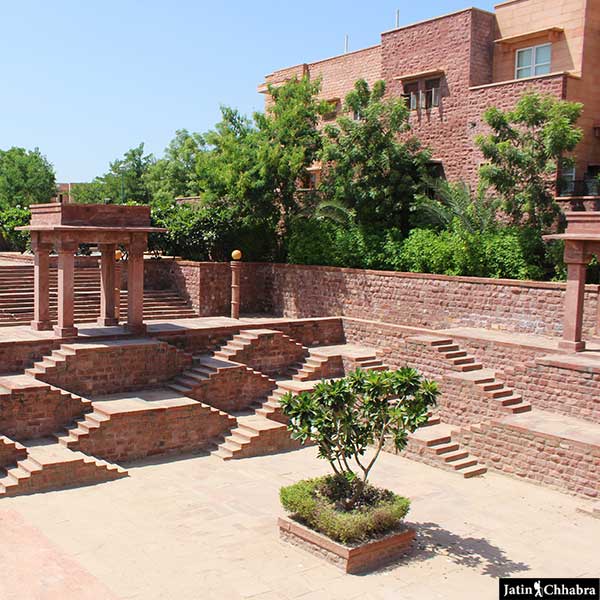
Birkha Bawri
Birkha Bawri is the third stepwell I visited in Jodhpur, and it’s the only 21st-century stepwell built in India. I had to take the permission of A. Mridul who is the architect of the stepwell, which is constructed to provide water to a whole housing society name Umaid Heritage, next to Umaid Bhawan Palace.
As per the management of Umaid Heritage Group, they were facing major issues to provide regular water supply in the newly built housing society. So when A. Mridul introduced the idea of a stepwell they immediately agreed, and it did wonders as now Umaid Heritage Group is storing over 17.5 million liters of rainwater every year, which is more than enough for daily household work of the people living in the society.
So, in simple terms, they have now reduced their water bill to half by accepting that stepwells, even today are useful and they have proved this, not as a theory, but as a practical. You can check my article with more pictures and details of Birkha Bawri.
Apart from these, there are 10,000 stepwells in Rajasthan alone because of every village in the state, which is more than 100 years old, had to build a stepwell.
Well, thanks to the current water supply mechanism, water is now available via taps, so now only Stepwell Travellers like me are visiting Ancient Indian Stepwells as to collect pictures and stories connected with them.
I do have plans to visit more stepwell in Rajasthan like:
- Chetan Das ki Bawri, Lohargal
- Chomu Stepwell, Chomu
- Banjaron ki Bawari, near Jaipur
- Bhandarej Baori, Alwar
Chances are very high that soon this list gets multiple by 10.
Stepwells from Gujarat.
After Rajasthan, the state of Gujarat has the highest number of stepwells and also one of the most decorated ones which I have mentioned at number 5 in this list of Ancient India stepwells. So, as I have shared details on Rani Ki Vav and Adalaj Vav, so let’s start with:
Stepwell number 18 – Modhera Sun Temple Kund
Location – Modhera, Mehsana, Gujarat INDIA
Age – 1027 AD
Built by – King Bhima I

Modhera Sun Temple Kund
Modhera Sun Temple is devoted to Surya (Sun God), and it has a Kund (stepwell) with 108 small temples built inside. The architecture of this stepwell suggests that this site was more of a spiritual place, rather than a stepwell to store water.
As per many historians, the water of this Kund was used for religious ceremonies, and the temple complex is built in such a way that the first ray of sunlight touches the statue of Vedic God Sun, placed in the main temple complex.
There is also three-day annual Modhera Dance Festival (organized by Gujarat Tourism Board) in the month of January, to celebrate the Uttarayan, (A festival connected with Sun).
Timings and location of Modhera Sun Temple
You can reach Modhera Sun Temple and Kund from Ahmedabad which is 100 km away, and the opening timing of Modhera Sun Temple is from 8:00 AM to 5:00 PM. Also, check out my article on Modhera Sun Temple which contains images and more information of the beautiful stepwell from the state of Gujarat.
Stepwell number 19 – Dada Harir Vav
Location – Ahmedabad, Gujarat INDIA
Age – 1485 AD
Built by – Sultan Mahmud Begada

Dada Harir Vav
Dada Harir Vav (Stepwell) is an octagonal shaped stepwell in Aswana, Old Ahmedabad. The Stepwell was built in 1485 AD, by Dhai Harir, who is said to be the foster mother or the superintendent of Mahmud Begada Haram (Sultan of Gujarat) the same person who finished the work of Adalaj Vav.
The history of Dada Harir Vav suggests that Dhai Harir was a dominant woman at the Sultan’s court and convinced the Sultan to create a stepwell in Ahmedabad city. The stepwell is built just next to a mosque, which is also many centuries old.
Dada Harir Vav has five floors, and the architecture of the stepwell is quite excellent. The goal here is to store rainwater and the final level you will see a big well which has a capacity to store huge amount of water.
Timings and location of Dada Harir Vav.
Dada Harir Vav is opened from 9:00 AM to 5:00 PM. There is no entry ticket, but still, the Vav is maintained my ASI.
Dada Harir Vav is in Aswana, old Ahmedabad and not too far from Ahmedabad Railway Station. You can also check my post on Dada Harir Vav for more information and pictures of this 15th century stepwell.
Stepwell number 20 – Jethabhai ni Vav
Location – Ahmedabad, Gujarat INDIA
Age – 1860 AD
Built by – Jethabhai Mulji

Jethabhai ni Vav
Jethabhai ni Vav is the second stepwell site I visited in Ahmedabad. This Vav (Stepwell) doesn’t get much tourist charm which Dada Harir Vav and the Adalaj Vav in Gandhinagar has obtained, but still, it is a part of Ahmedabad historical monuments.
As per the archives of ASI, James Burgess in 1905 AD has mentioned that Jethabhai Mulji built Jethabhai ni Vav in the year 1860 and it was outside Ahmedabad in Isanpur, which is now a part of modern Ahmedabad city. The length and width of Jethabhai Mulji is 210 x 22 feet (Length and width)
Timings and location of Jethabhai ni Vav.
As Jethabhai ni Vav is under the management of ASI, so this Vav is opened from 8:00 AM to 5:00 PM. There is no entry fee, and one needs to enter the old Ahmedabad city to visit this stepwell. The location of the Vav is Paras Nagar, Ghodasar which is 8 km south from Ahmedabad railway station. You can read my article on Jethabhai ni Vav for more details and images.
Stepwell number 21 – Helical Vav Stepwell
Location – Champaner, Gujarat INDIA
Age – 16th century
Built by – No confirmed data

Helical Vav Stepwell
40 km west from Vadodara, lies the ruins of a city, which was once the capital of Gujarat, in late 15th century. I’m talking about Pavagadh, Champaner.
Pavagadh Champaner is now an Archaeological Park, which was built by Mahmud Begada, who shifted his capital from Ahmedabad to Pavagadh.
Just outside the main entry gate of this Pavagadh Champaner Archaeological Park, there is a round shaped small stepwell, created to store water and was very useful for the locals of this region.
The name of this stepwell (Vav) is Helical Vav, and it’s made up of bricks & stone slats which lead to the bottom of the well through to stairs shaped structure.
I visited Pavagadh Champaner Archaeological Park in November’16, and Helical Vav is one of many fantastic sites one can see in this Archaeological Park, which didn’t even survive for more than 50 years.
You can read the full story and check the picture of this part at my post on Pavagadh Champaner Archaeological Park.
Stepwells from Karnataka.
Apart from the Hampi Pushkarani, mentioned in point number 7, there are many stepwells in the state of Karnataka. Though the stepwells which I have seen are mostly from the northern part of the state and all of them were built along with a temple. So apart from Hampi Pushkarani, have a look at these stepwells:
Stepwell Number 22 – Trikuteshwara Temple Stepwell
Location – Gadag, Karnataka INDIA
Age – 1050-1200 AD
Built by – Kalyani Chalukyas

Trikuteshwara Temple Stepwell
110 km from Hampi, lies a small but modern city of Gadag which is also known as the “City of Temples” as there are more than 50 temples of Hindu and Jain mythology. One of them is Trikuteshwara Temple, which has a stepwell that dragged me to Gadag from Hampi.
Trikuteshwara Temple is an 11th-century temple built by Kalyani Chalukyas rulers. The term Trikuteshwara, suggests that this temple is dedicated to Shiva, but it’s devoted to Saraswathi (Goddess of Education).
Trikuteshwara Temple was destroyed during the wars with Bahamani Sultans against Hampi, and because of this the statue of Saraswathi was damaged, and no offering is submitted in this temple.
Nevertheless, the temple architecture is quite exquisite and final wall of the temple, there is a deep stepwell, which as per the local priest, has no name and was built for temple rituals only.
Stepwell Number 23 – Lakkundi Stepwell (Manikeshwara temple)
Location – Lakkundi, Karnataka INDIA
Age – 1050-1200 AD
Built by – Kalyani Chalukyas

Lakkundi Stepwell at Manikeshwara temple
Just 12-13 km from Gadag, there is a small rural town of Lakkundi, which was a sacred place from 11th to 15th century as this small village has ruins of more than 50 temples and most of them have stepwells. Sadly most of they are destroyed, but still, one survived.
Manikeshwara Temple is at the center of Lakkundi where you will find a Kalyani (anther name for Stepwell). Thankfully this temple and Kalyani is preserved by ASI, so it’s in good shape.
I didn’t get that who is the chief deity of the temple as temple structures in India vary from region to region. But I do understand that Manikeshwara and its stepwell were built during the Chalukyas period.
The stepwell has three entry gates, though only one is open and the structure of this whole complex suggest that this stepwell was prepared for temple religious ceremonies only, rather than for everyday public use.
Stepwell Number 24 – Huchchimalli Temple & Stepwell
Location – Aihole, Karnataka INDIA
Age – 11th century
Built by – Chalukya Kings

Huchchimalli Temple Stepwell Aihole
Huchchimalli Temple is one of many temples in Aihole, which is a small city full of ancient temples. The Huchchimalli Temple has a stepwell which has figures (small in size) crafted in the stepwell walls. The statues are of Dikpalas, Mahishamardani, Bharma, Vishnu and many characters of the stories of Hindu mythology.
The Chalukya Kingdom built this temple, and it’s considered as a monument of Kalyana Chalukya Monuments, which were mostly built in 11th century AD.
Stepwell Number 25 – Durga Temple & Stepwell
Location – Aihole, Karnataka INDIA
Age – 11th century
Built by – Chalukya Kings

Durga Temple Stepwell Aihole
Aihole is a temple city famous for it’s “Group of Temples” constructed in the 11th century. The main attraction here is the “Shri Durga Temple.” and before entering this temple complex (which even has a resourceful museum), I had no idea that there is a stepwell built inside.
At the opposite site from the ticket counter or main entry gate, there is single storey stepwell structure, which has survived and is still in good shape to store water. But as all the ancient temples in Aihole are now monuments, this stepwell is just a display unit for travellers like me and you. Never the less, the main temple’s structure is marvelous and gives a feeling of Indian Parliament.
And with this, I finish the list of stepwells explored in northern Karnataka. I feel that Karnataka doesn’t face drought-like situations as seen in Rajasthan or Gujarat and most of their Stepwells (referred as Pushkarani and Kalyani) are wells used for temple rituals.
The most attractive design and science of stepwells which caught my attention were the Pushkarani’s in Hampi.
King Krishnadevaraya, a very famous ruler of Vijayanagara Empire, developed a network of stepwells in Hampi to provide reliable water management system. Even today many researchers are trying to study the water drainage system of Hampi which involves collecting rainwater in many stepwells which are interconnected through underground tubes.
My mission for future
When I started covering stepwells, I though that I need to cover around 15 odd sites, but that number quickly got a zero at the end (150) as there are more than 100,000 stepwells in India.
Though I don’t plan to visit all these 100,000 stepwells, never the less, the ones that are in good condition and still used by locals for water restoration or religious ceremonies, are worth visiting.
So, my work for future is to find stepwell and visit them for this grandest guide of Ancient Indian Stepwells.




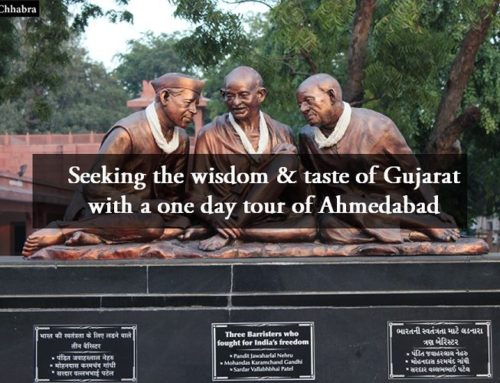


Hi Jatin,
I cant begin to tell you how impressed and inspired I am with your blog. I am an avid traveller (75 countries so far) and recently relocated to India 5 months back in Gurgaon. This time I decided that I will focus on India travel and being fascinated with the whole concept of bawri’s, I was starting to research on baori’s and stumbled on your blog. Needless to say that there are amazing pointers here. I yet have to see most of the baori’s and I will hopefully son start doing that But I di want to tell you about the town of Chanderi, MP. I went here a few weeks back and again that small town is know for a stepwell in every gali-nukkad. As you can imagine that most of them are ruins and you will never be able to find any, but I was lucky to at least see 2 of them because they have ben properly maintained by MP Tourism. Chakla Bawri and Battisii Bawri were the ones that I was able to see. I tried to find Gol Bawdi and Musa Bawri, but couldn’t find much help, so had to skip. But I bet they are there. I would highly highly recommend visiting Chanderi.
I am now gonna use your amazing blog and visit as many myself. Maybe some day will go travel with you.
Hello! sir, you seems to be interested in bawaris.i can tell you some neglected but attractive bawaris.alijan ki bawari near chhota bada talb narnaul/baba khetanath govt poltecnic campus narnaul bawari.one beautiful bawari in lohargal village near udaipurwati town in jhunjhunu distt rajasthan.this step well is in good condition.you can search it on google.i can tell you around 50 talabs all around of shekhawati region of rajasthan in the little town-pilani ;cirawa ;bagad; jhunjhunu ;madawa; fatehpur ;laxman garh; ramgarh; bisau ;mahansar; udaipur wati; lohargul ;sakambharidevi; khatu shyam ;sikar ;ratannagar; churu very very vast area.and most attractive magnificent shekhawati havalis.
I fogot one bawri in mahendergarh haryana neargovt primary school dhani mohalla; bucholi road mahendergarh..
Jatin thank your travel info. I discovered the world of Stepwells 3 years ago but haven’t yet visited any but hope to be in Jaipur in early Dec or late Jan. Your descriptions are inspiring so very much appreciated.
Best wishes
I recently visited jodhpoor abd seen my first stepwell. And it made me so fascinated that i plan to see as much stepwell as i can. But today only i got a memory that the jodhpur stepwell is not my 1st stepwell but its third. As i have visited one in my childhood in chunar garh fort. And one in varanasi near assi ghat 5 years before.
The day before yesterday i also visited the amer stepwell. And i am now planning to visit Abhaneri which i regard as king of all stepwells.. thanks for your blog. It was a pleasure reading that
A very interesting blog. I first saw a stepwell on the BBC programme by Joanna Lumley and we are visiting India in October to visit a few places in Rajastan. We will certainly be including a few stepwells.
Hello Jatin,
Thank you for such a good story written. We are all really can’t imagine how impressive of people at that time was. (to build such this massive construction) I am very interested in irrigation system and that is why I do like this story. Is there anyway that we could know who were the real architects?
Hi Jaten, your blog is really impressive. I didn’t know about stepwells in India and in general. Did the people who built them use techniques similar to those used in ancient Egypt? Are stepwells typical only in India or do you know about symilar systems in other countries?
Hi Emm, Majority of Stepwells are in India (or South Asia) but you can definitely find a few in Europe too. Like Quinta da Regaleira, in Sintra Portugal and would love to visit it someday…
Hi Jatin,
A good source of information on the stepwells of India. Makes it easier for people like me to plan our itinerarier… :-) Have visited some like the Rani ni Vav, Modhera and the ones at Bundi and Hampi. Looking forward to seeing the ones in Shekhawati region.
By the way… far as I know, stepwells are typically Indian. The rare ones found outside are usually not meant as water storage places but have been commissioned for other reasons….
VERY WELL. NICE INFORMATION. THANKS FOR SHARING
NICE WORKING. IS IT POSSIBLE TO MAKE AND SHARE VIDEOS OF THESE STEP WELLS?
yes, apart from a few like agrasen ki baoli or Chand Baori, as here u need permission.
There must be some stepwell not known by people also not covered by ASI
Does anyone know about such type of stepwell in DELHI
Hi Jatin,
a couple of years ago we visited Orvieto in Umbria, Italy, a very geologically and historically interesting aeria . We found the Pozzo di San Patrizio, english: “St. Patrick’s Well” built in the 15 hundreds by Pope Clement VII based on similar ideas of a circular construction of opposit spiral staircases. This could fit in Your programm visiting special well constructions, not so old but a very interesting and impresively more than 60 m deep. I couldn’t find a link without advertisments, so just look for the italian name.
Hi Michael, Yeah just google Pozzo di San Patrizio and the images are of a stepwell. Had even saw a same structure in Portugal, which I want to visit. Its Quinta da Regaleira. Might visit them both now :)
Thanks for sharing the site name.